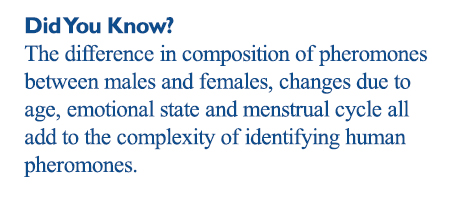Pheromones are chemicals secreted by animals that influence the behavior of recipient animals of the same species, often to attract mates. That some form of chemical communication occurs between animals was first recognized as far back as ancient Greece, when the Greeks noted that male dogs were attracted to secretions from female dogs in heat. Bombykol, a pheromone released by female silkworm moths, was the first pheromone to be chemically characterized by Nobel Prize–winning German chemist Adolf Butenandt in 1959.
Since then, pheromones have been identified in a plethora of animal species, including flies, fish, ants and mice. However, human pheromones have famously eluded scientists. This is because there are several sources of pheromone-like compounds in humans: axillary (armpit) glands, salivary glands, seminal and urine secretions, all of which are composed of hundreds if not thousands of chemicals. Moreover, the often-accepted primary source of potential pheromones, axillary gland, also breeds bacteria, which change the chemical composition of the secretions. In addition, the difference in composition between males and females, changes due to age, emotional state and menstrual cycle all add to the complexity of identifying human pheromones.
 Although the existence of human pheromones, specifically human sex pheromones, is highly controversial, scientists agree that natural human scents can modulate the behavior of other humans. Several studies have shown a correlation between the perceived attractiveness of members of the opposite sex and an appealing smell associated with their sweat. A paper published in 1991 and follow-up studies conducted in the early 2000s indicated that the steroid hormones androstadienone (AND), found in male sweat, urine and saliva; and estratetraenol (EST), found in female urine, might be putative human sex pheromones. Perfume companies immediately started selling products containing these chemicals, or their derivatives, and marketing them as “love potions”.
Although the existence of human pheromones, specifically human sex pheromones, is highly controversial, scientists agree that natural human scents can modulate the behavior of other humans. Several studies have shown a correlation between the perceived attractiveness of members of the opposite sex and an appealing smell associated with their sweat. A paper published in 1991 and follow-up studies conducted in the early 2000s indicated that the steroid hormones androstadienone (AND), found in male sweat, urine and saliva; and estratetraenol (EST), found in female urine, might be putative human sex pheromones. Perfume companies immediately started selling products containing these chemicals, or their derivatives, and marketing them as “love potions”.
However, there was no consensus in the scientific community about the validity of this claim. Recently, a study published in the Royal Society Open Science journal has called into question these claims, by reporting that the pheromones AND and EST have no effect on "mate perception." In this study, the scientists tested 94 heterosexual women and men on two tasks. The first task involved perceptions of gender; the second task involved perceptions of attractiveness and unfaithfulness. Each participant was evaluated on the same task twice, on consecutive days. They either received clove oil as a control on one day and one of the two putative pheromones (AND or EST) on another day.
The order of control odor and pheromone odor was randomized. They were first asked to identify the sex of a "gender-neutral" face generated by combining many photos of men and women. Participants were then asked to rate the attractiveness of the faces and whether they thought that person was likely to commit adultery, a factor often considered when choosing a mate. The scientists worked under the hypothesis that if AND and EST truly were gender-specific pheromones, then they should affect behaviors such as mate perception, which are reproductively relevant.
The double-blind study showed that exposure to these chemicals had no effect on gender, attractiveness or unfaithfulness ratings by the participants. Therefore, the researchers concluded that the most plausible explanation for their results is that these two chemicals are not sex pheromones. This study does not rule out the possibility of the existence of human sex pheromones but strongly suggests that they might not be AND or EST.
References
- Putative sex-specific human pheromones do not affect gender perception, attractiveness ratings or unfaithfulness judgements of opposite sex faces
- Emergence of AND and EST as putative pheromones
Related Content
- Altering the ‘Flavor’ of Humans Could Help Fight Malaria: Novel study identifies an area of the mosquito brain that mixes taste and smell
